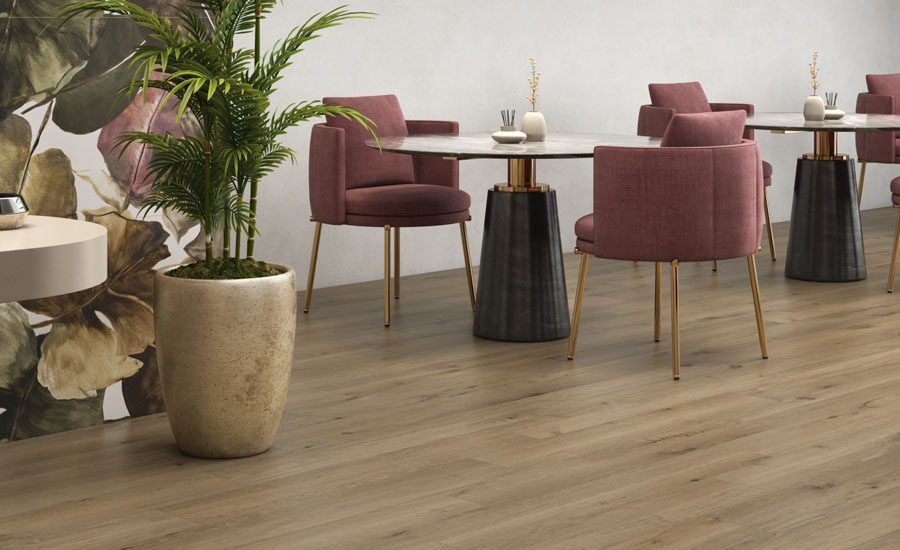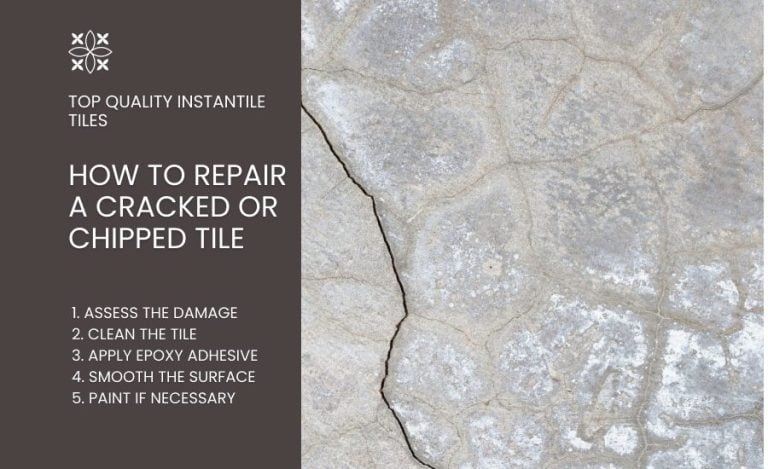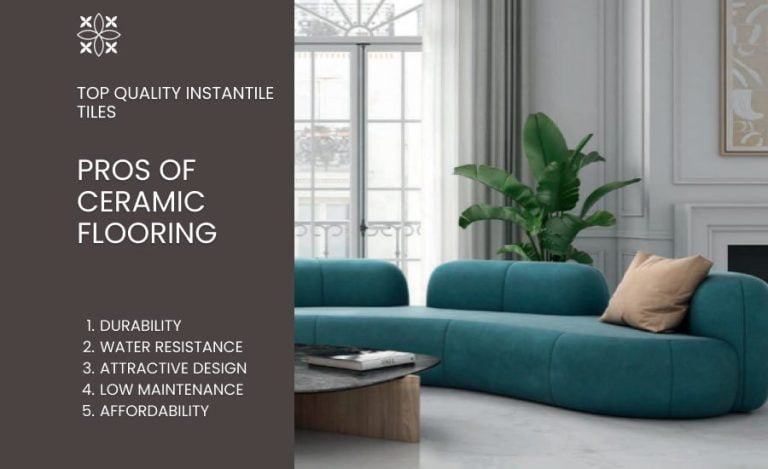Tiles vs. Vinyl Flooring: Key Takeaways
- Flooring affects your space’s style, functionality, and maintenance needs
- Ceramic tiles are kiln-fired from natural clay for durability and design flexibility
- Vinyl flooring is a synthetic option made from PVC, known for its affordability and easy upkeep
Choosing the right flooring is one of the key decisions when designing or renovating a space.
While the market offers various options, two popular choices often come up in these discussions: tiles and vinyl.
In this guide, we will:
- Discuss tiles vs. vinyl flooring in terms of aesthetics, durability, maintenance, cost, and sustainability
- Explain their advantages and drawbacks
- Answer FAQs surrounding tiles vs. vinyl flooring
Ceramic Tiles vs. Vinyl Flooring: A Detailed Comparison
Seems like a hard choice? Let’s compare tiles and vinyl so you can choose a flooring option that meets your needs.
Aesthetics
Both tiles and vinyl come in a wide range of styles that can make your home, restaurant, or shop look elegant and modern.
Both flooring types provide options that closely mimic natural materials, allowing you to enjoy the beauty of wood, stone, or metal without the associated costs and maintenance challenges.
Durability
Ceramic tiles are known for their durability. If not chipped or cracked under heavy objects, they can last 20-50 years or more.
Vinyl flooring is typically less durable than tiles, having a lifespan of 10-20 years. Due to its flexibility, it also resists cracking.
Maintenance and Cleaning
Both flooring types are easy to clean and maintain as you only need a mop and a cleaning solution to make them fresh again.
Ceramic tiles might need periodic sealing to improve water resistance, and their grout lines need harder scrubbing.
Installation
Traditional tile installation is typically labor-intensive and time-consuming as it requires preparing the surface, applying adhesive, and grouting.
However, newer interlocking tile options like Ceramista’s simplify installation by connecting tiles without adhesive or grout.
Vinyl flooring installation is straightforward — it uses peel-and-stick backing or click-lock designs that allow you to place it over existing surfaces without the need for adhesives or specialized tools.
Cost
Most Ceramic tile options are typically more expensive due to the material and production costs.
Vinyl is more budget-friendly compared to tiles, and installation costs are generally lower.
Sustainability
Ceramic tiles are more environmentally friendly because they are made from natural materials.
Vinyl flooring is derived from petroleum-based products, making it less eco-friendly.
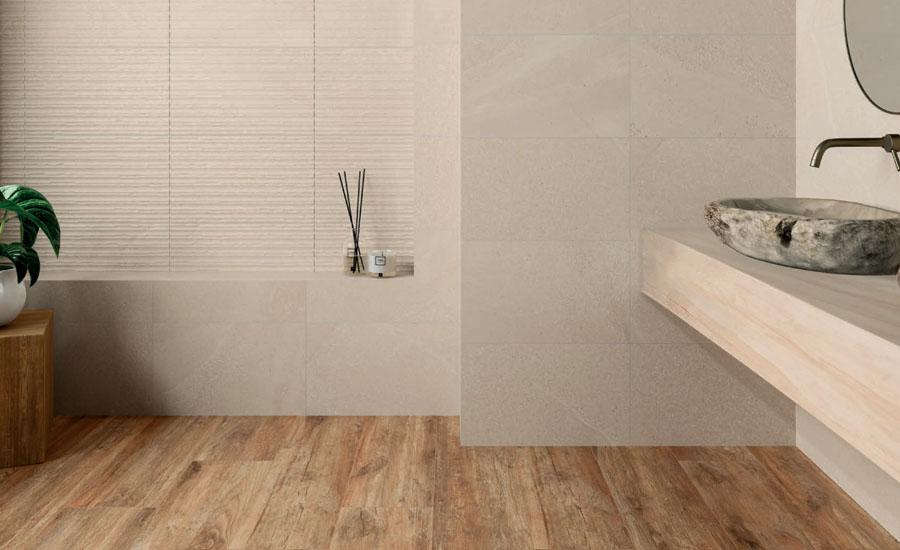
Ceramic Tiles Explained
Ceramic tiles are a type of flooring made from natural clay and other materials that are molded into shape and fired at high temperatures.
This process results in a hard, durable surface that is often glazed to make tiles shiny and improve water resistance.
The ability to resist moisture makes tiles a preferred flooring choice, especially for kitchens and bathrooms.
While giving your space a classic look, different designs, colors, and textures also allow you to create a space that has its own character.
A Closer Look at Vinyl Flooring
Vinyl flooring is a synthetic product typically made from polyvinyl chloride (PVC) plastic.
It uses advanced photographic technology to mimic natural materials like wood or stone, offering a cozy and stylish look.
Versatile and easy to install, vinyl is available in various forms, such as luxury vinyl tiles (LVT) and vinyl planks.
Ceramic Tiles vs. Vinyl: Pros & Cons
When choosing between tiles and vinyl flooring, it’s key to weigh their advantages and disadvantages.
To help you with your decision, here is a breakdown of the pros and cons for both flooring types.
Ceramic Tiles Pros
- Durable and resistant to wear, scratches, and dents
- Water-resistant
- Easy to clean (and you don’t need special cleaning products)
- Eco-friendly
Ceramic Tiles Cons
- More expensive
- Can feel cold underfoot (if you live in cold climates and do not plan to combine them with radiant heating)
- Can chip or crack under very heavy objects
- Require professional installation
Vinyl Flooring Pros
- Budget-friendly in terms of materials and installation
- Softer and warmer underfoot than ceramic tiles
- Can be installed on your own as a DIY project, without the need for professional help
- Moisture resistant
Vinyl Flooring Cons
- Shorter lifespan compared to ceramic tiles
- Prone to scratches and dents
- Can fade over time if exposed to sunlight
- Adds less value to a home than ceramic tiles
- Have a chemical, petroleum-based composition which may raise concerns for environmentally conscious consumers
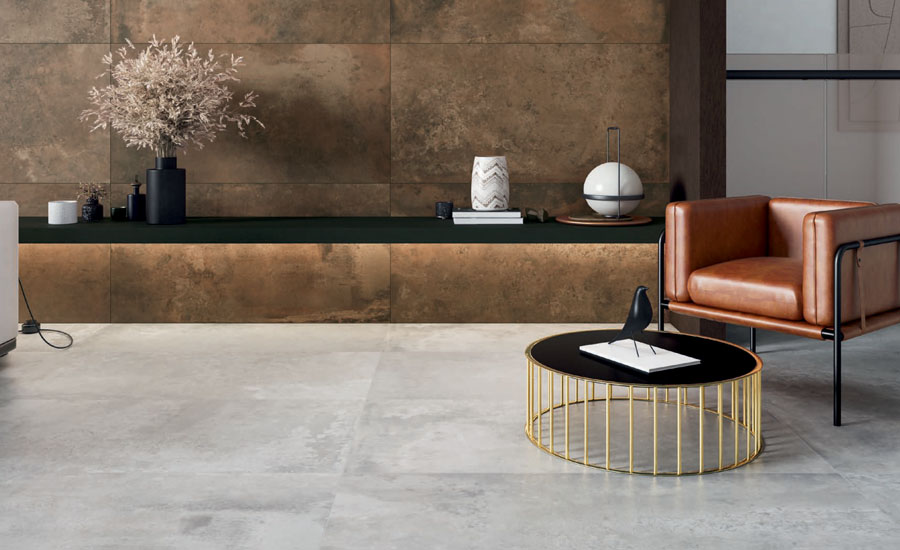
Why Choose the Right Flooring Option?
The right flooring for your home or commercial space impacts how your place looks, how you can use it, and the time and effort it takes to clean it and keep it in perfect shape.
Your flooring choice can also contribute to the resale value, with types offering superior quality, longer lifespan, and greater appeal.
While we’ll be comparing tiles with vinyl below, you can also check our guides on other flooring options:
Discover the Smarter Way To Tile at Ceramista
At Ceramista, innovation is at the heart of everything we do. What truly sets us apart is our proprietary INSTANTILE interlocking system, a breakthrough in tile technology that allows for installation up to nine times faster than traditional methods.
With no need for glue, grout, or specialized tools, INSTANTILE makes flooring projects cleaner, quicker, and more cost-effective.
Whether you’re outfitting a home, office, or commercial space, you’ll benefit from reduced labor, minimal downtime, and a flawless finish.
Effortless maintenance is part of the design: if a tile is ever damaged or stained, it can be removed and replaced individually, without disrupting the surrounding area.
Beyond the system, our tiles offer a host of additional advantages:
- Versatile aesthetics: Choose from designs that authentically replicate wood, stone, or metal, creating a variety of looks for any interior style.
- Spanish heritage quality: Crafted with the care and artistry that Spanish tilework is known for, our products combine elegance with long-lasting performance.
- Sustainable innovation: Manufactured at Europe’s largest solar-powered tile facility using eco-conscious materials, our tiles support a greener future.
Ceramista is where speed, style, and sustainability meet. Choose smarter. Choose Ceramista.
Ceramic Tiles vs. Vinyl Flooring: FAQs
Now, let’s address some common questions that you may still have regarding vinyl vs. tiles.
Is vinyl flooring better than tiles?
It depends on your specific needs. Vinyl is often more budget-friendly and easier to install while ceramic offers greater durability and longevity.
Which flooring works better in bathrooms and kitchens, tiles or vinyl?
Both tiles and vinyl are water-resistant and can be used in bathrooms and kitchens. However, prolonged exposure to moisture of vinyl surfaces can cause issues like warping, buckling, mold and mildew growth, and fading.
Can I install vinyl flooring over my current floors?
Yes, many types of vinyl flooring can be installed directly over your current surfaces, making the process easier compared to other flooring types.
What adds more value to a home, tiles or vinyl flooring?
Ceramic tiles provide higher resale value to your home or commercial space due to their durability and beautiful appearance. Vinyl may not offer the same return on investment as potential buyers might view it as a lower quality flooring type.
Can I use tiles and vinyl flooring with underfloor heating?
Both ceramic tiles and vinyl can be used with underfloor heating. However, they may require different preparations before installation. Also, make sure you check compatibility with specific heating systems.
Is tile or vinyl more suitable for high-traffic areas?
Tiles are an excellent choice for high-traffic areas due to their durability and resistance to scratches and dents. Vinyl flooring can handle moderate foot traffic but may wear off over time in very busy spaces.
For homes with pets, is vinyl or tile the better choice?
Both vinyl and tiles are pet-friendly, but tiles are more resistant to scratches and staining. Vinyl flooring can handle pets but may be scratched over time, especially softer vinyl types.
Can I use vinyl in outdoor spaces?
Most vinyl types are not suitable for outdoor use, as they can warp or fade when exposed to the elements. However, you can look for special vinyl flooring designed for outdoor use.
Which flooring is more slip-resistant, tile or vinyl?
Tiles, particularly textured or matte varieties, can offer better slip resistance. Vinyl can become slippery when wet unless it has a textured surface or slip-resistant coating.
